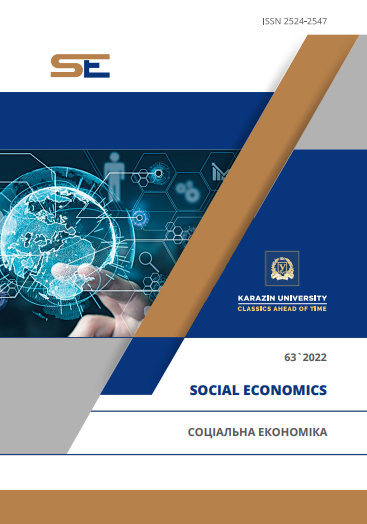EUROPEAN VECTOR OF INTELLECTUAL MIGRATION
Abstract
Abstract. The scientific article analyses the approaches of domestic and foreign scientists to determine the essence of the concept of "intellectual migration". We have determined that intellectual migration is equated by scientists with the migration of highly qualified workers with higher education for employment abroad to realize their professional and intellectual abilities on purpose. The authors analyzed the dynamics of the number of issuances and renewals of the EU Blue Card, which confirms the high level of interest of Europeans in the employment of intellectual migrants. In 2019, Ukrainian intellectual migrants owned about 5% of all issued and updated EU Blue Cards. In general, the value of this indicator has increased more than 12 times over the last 9 years. We analyzed vacancies for employment of intellectual migrants from Ukraine in the European Union on the job search site robota.ua during October 2021. The study found that the most popular areas of intellectual labour migration among EU member states were Poland (42%) and Germany (13%). In terms of professional orientation of current vacancies, advertisements for employment of managers with a share of 28% in total prevail. The authors investigated the relationship between the «brain gain» indicator in the Global Talent Competitiveness Index and the country’s economic growth, based on gross domestic income per capita. Based on the calculated value of Pearson’s pairwise correlation coefficient (0.882) on the example of the European Union, we found a significant impact of the level of attractiveness of the tap for intellectual migrants on its economic prosperity. In order to detail this relationship, the authors developed an economic-mathematical model of the form y = 718.77x-5213.7, which proves that with increasing value of the indicator "brain growth" in the Global Index of Talent Competitiveness, GDP per capita increases.
Downloads
References
Weber, T., & Adăscăliței, D. (2021). Tackling labour shortages in EU Member States. Publications Office of the European Union, Luxembourg.
Oprescu, G. (2020). The consequences of non-EU labor instability. Technium Soc. Sci. J., 10, 645. doi: https://doi.org/10.47577/tssj.v10i1.1443.
Аytac, S., & Aydin, G. Ç. (2019). Analysis of the Effects of Pull and Push Factors on Brain Drain: An Example of Turkey. Journal of Social Economic Research, 6(2), 74-84. doi: https://doi.org/10.18488/journal.35.2019.62.74.84.
Mihăilă, A. (2018). Non-economic factors influencing highly-skilled migration. Review of Economic Studies and Research Virgil Madgearu, 1, 27-53. doi: https://doi.org/10.24193/RVM.2019.12.32.
Podra, O. et al. (2020). The impact of migration processes on the economy of Ukraine: Trends, reasons, consequences. Journal of the Geographical Institute" Jovan Cvijic", 70.2, 171-179. doi: https://doi.org/10.2298/IJGI2002171P.
Mayda, A. M., Peri, G., & Steingress, W. (2022). The political impact of immigration: Evidence from the United States. American Economic Journal: Applied Economics, 14(1), 358-89. doi: https://doi.org/10.1257/app.20190081.
Levchuk, K. O. (2019). Intellectual migration: problems and ways of solution. Priazovsky Economic Bulletin, 1(12), 158-161.
Bokayev B., Torebekova Z., Davletbayeva Z. (2020). Viesoji politika ir administravimas. Public policy and administration, 19, 25-35.
Parkhomenko, N. (2014). Problems of intellectual migration of Ukraine. Ukrainian studies, 17, 37-39.
Naumovski, L. (2021). The Attraction of Intellectual Migration - Brain Drain or Exodus of Human Capital in Southeast Europe - Western Balkans and North Macedonian Transitional Conditions. The International Journal of Social Sciences World (TIJOSSW), 3(2), 1–24.
Koshulko, O. (2018). Examination of the contribution of intellectual migration to the sustainable development of countries worldwide. Culture of peace and sustainable development education, 14-22.
Bielozorova, A., & Korovina, N. (2020). Osvitnia mihratsiia yak nevidiemna chastyna intelektualnoi mihratsii. [Educational migration as an integral part of intellectual migration]. Bulletin of SSU. Series "Economics", 3, 140-148. (in Ukrainian)
Khan, J. (2021). European academic brain drain: A meta-synthesis. European Journal of Education, 56, 265-278. doi: https://doi.org/10.1111/ejed.12449.
Fries-Tersch, E., Jones, M., & Siöland, L. (2021). Annual Report on Intra-EU Labour Mobility 2020. European Union.
Kurbet, O. P. (2020). Mizhnarodna trudova mihratsiia v nezalezhnii Ukraini: rysy ta osoblyvosti. [International labor migration in independent Ukraine: features and features]. History of the national economy and economic thought of Ukraine, 53, 362-386. (in Ukrainian)
Kim, S., Chang, S., & Castro-Lacouture, D. (2020). Dynamic modeling for analyzing impacts of skilled labor shortage on construction project management. Journal of Management in Engineering, 36(1), 04019035. doi: https://doi.org/10.1061/(ASCE)ME.1943-5479.0000720.
Brucker Juricic, B., Galic, M., & Marenjak, S. (2021). Review of the Construction Labour Demand and Shortages in the EU. Buildings, 11(1), 17.
Oliinyk, O., Bilan, Y., Mishchuk, H., Akimov, O., & Vasa, L. (2021). The Impact of Migration of Highly Skilled Workers on The Country’s Competitiveness and Economic Growth. Montenegrin Journal of Economics, 17(3), 7-19. doi: https://doi.org/10.14254/1800-5845/2021.17-3.1.
Alshoubaki, W., & Harris, М. (2021). Multiple streams theory: Insight into the global compact on migration, Journal of International Studies, 14 (1), 74–88. doi: https://doi.org/10.14254/2071-8330.2021/14-1/5.
Kropp, B. (2021). 9 Trends That Will Shape Work in 2021 and Beyond. Harvard Business Review. Retrieved from https://hbr.org/2021/01/9-trends-that-will-shape-work-in-2021-and-beyond?fbclid=IwAR3iqON67gTN1kkMehaNp9Xv0xFDUpTM6Lm_0e92Z-MpyaIG4LsO2aAY2Y4.




